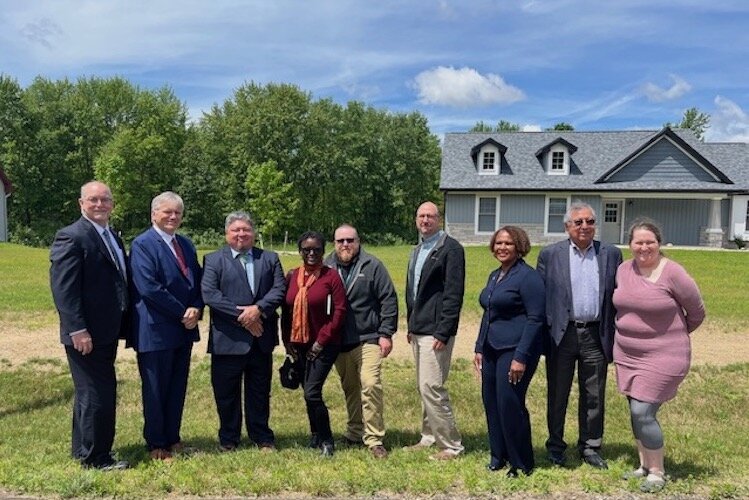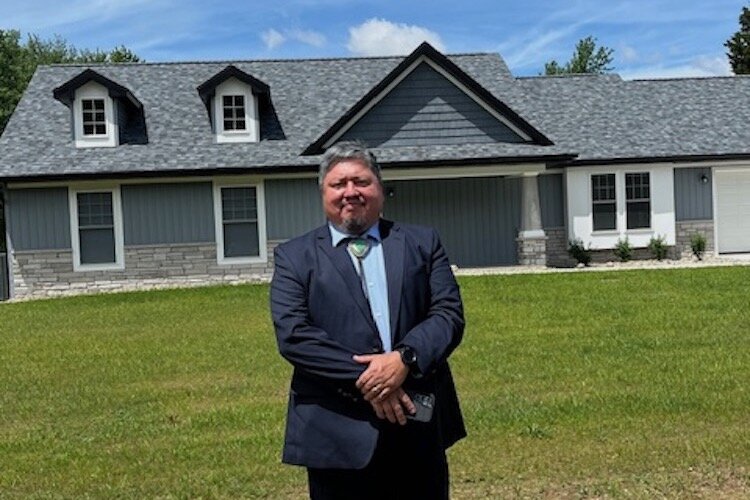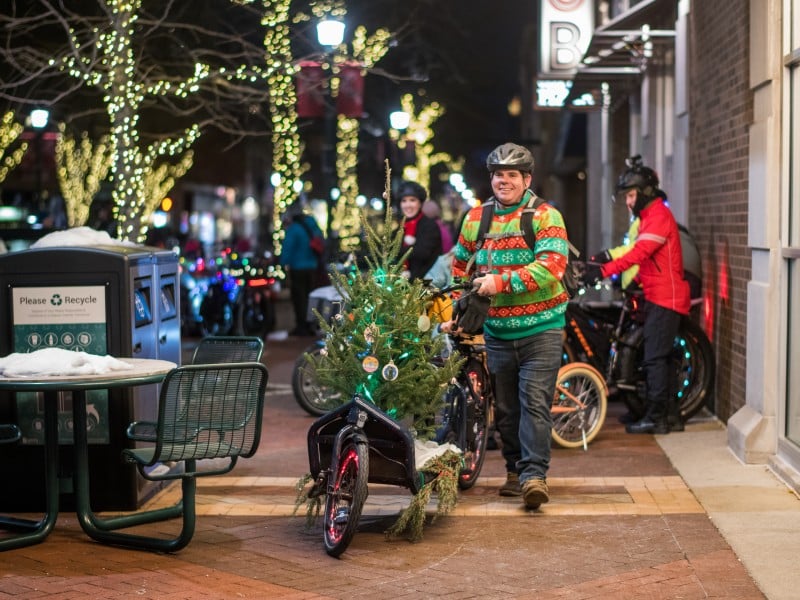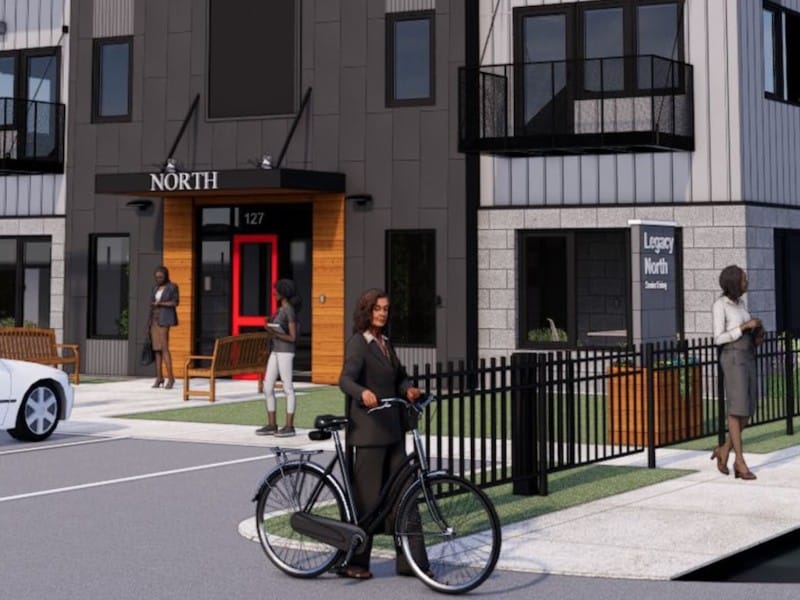Road home for members of Tribe with roots in Calhoun County paved with HUD dollars
“Your great ancestors had to fight for everything just like you continue to fight. It is important that we don’t just talk about it, but actually do something," said HUD representative Richard Monnocchio in an announcement of a $1M grant for Pine Creek Indian Reservation housing.
Editor’s note: This story is part of Southwest Michigan Second Wave’s On the Ground Battle Creek series.
CALHOUN COUNTY, MI — A housing shortage at the Pine Creek Indian Reservation is preventing members of the Nottawaseppi Band of the Huron Potawatomi (NHBP) from coming home.
The leadership of the NHBP is hopeful that an increase in funding and a new competitive grant from the U.S. Department of Housing and Urban Development (HUD) will provide them with the financial resources to whittle down a waiting list of 25 Tribal members who want to live near the Pine Creek Indian Reservation. Their homes will be part of Phase 9 of the Tribes home construction initiative which began in 2007 and resulted in six new homes at Pine Creek, says Ben Tenney, NHBP’s Housing Director.
On May 29, HUD officials gathered with NHBP leadership at Pine Creek to announce that the Tribe will receive $1 million in federal funding this year, an increase of $600,000 from 2023. The gathering also served as the backdrop for the announcement of the availability of $150 million through the Indian Housing Block Grant (IHBG) Competitive program for affordable housing.
“This funding is designated for affordable housing projects benefiting low-income families in American Indian and Alaska Native communities,” says Richard Monocchio, HUD Principal Deputy Assistant Secretary for Public and Indian Housing, of the IHBG competitive grant.
In the first eight phases of the NHBP’s home construction efforts, 37 homes were built, Tenney says. He estimates that 283 additional housing units are needed to accommodate tribal members seeking to live on or close to Pine Creek.
In this latest building phase, four homes have already been built on an 80-acre site about one mile east of Pine Creek. They are located on No-Wek Way, the road named for a Tribal Elder who has passed.
“There’s a total of 17 developable acres,” Tenney said during a bus tour highlighting completed units and those to be constructed with HUD representatives. “We have space for 17 or 18 housing units. Construction will begin this month or in July on the next four houses.”
Since the Tribe became federally recognized in 1995, funding from HUD covered the cost of constructing 30 homes at Pine Creek, says Dorie Rios, NHBP Tribal Council Chairperson.
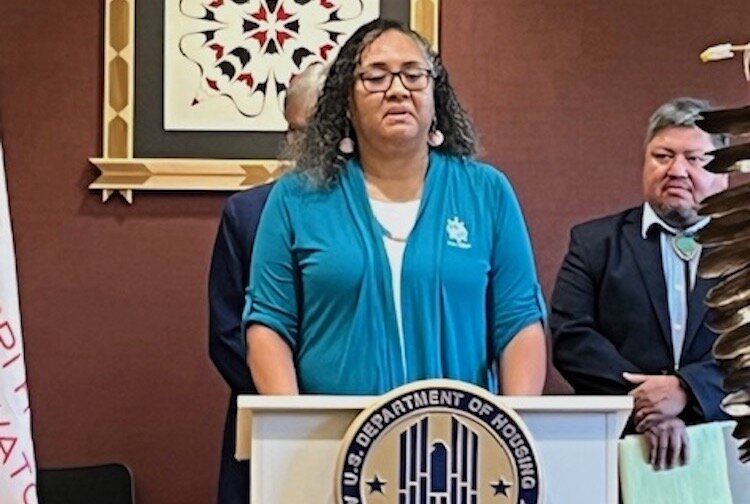
Dorie Rios, NHBP Tribal Council Chairperson, speaks during a press conference to announce increased HUD funding to the Tribe.
“We are blessed,” she says of the increased funding to the Tribe and the availability of the competitive grant.
In a 2020 Second Wave story, Rios said at any given time they had a waiting list of between 25 and 30 tribal members who wanted to live on or near the reservation.
At one time, the Potawatomi Nation encompassed lands along the Southeastern shoreline of Lake Michigan, from Detroit to Grand Rivers, and southward into Northern Indiana, Ohio, and Illinois. Tribal Members were later forced to cede the remainder of their “reserved lands” contained within the “Notawasepe Reserve” and were relocated to lands west of the Mississippi River, according to the NHBP website.
During the Potawatomi Removal, a group of Tribal Members escaped and returned to their native lands in Michigan. The Nottawaseppi Huron Band of the Potawatomi Tribe now resides on the Pine Creek Indian Reservation in Fulton. NHBP began seeking federal recognition before 1935.
“We have a few private homesteads on the reservation that tribal members established as their homes before tribal recognition,” said Dan Green, Chief Planning Officer for the NHBP, during the bus tour.
Rios recalled two Tribal members “who are no longer with us who spent their personal and professional lives fighting over and over again to get us a seat at the table to talk about how important it is to get safe and affordable housing.”
One of those individuals was relentless in his outreach to plead the Tribe’s case which included trips to Washington, D.C., to be heard by federal officials.
“Because we weren’t federally recognized at that time, we couldn’t get a seat at the table. Fast-forward to now. We have a seat at the table,” Rios says.
In her earliest years of working with NHBP, Rios was a Community Representative, a role that included transporting Tribal Elders, one of whom told her that everything comes full circle.
Rios saw a sign of that belief prior to the May 29 gathering when she saw a turtle standing high upon its haunches in a next-door neighbor’s driveway, symbolizing that “things have come full circle.”
“I strongly believe our ancestors are with us,” she says.
Dollars and sense
Leveraged with Tribal funds, the $1 million from HUD will put an estimated $2.5 million into the NHBP’s economy, says Neil Whitegull, Area Administrator of HUD Eastern Woodlands Office and member of the Ho-Chunk Nation Tribe in Wisconsin.
“This demonstrates that little tribes can compete and have the capacity to write the grant. Since 1997, 37 housing units have been constructed here,” he told those at the NHBP gathering. “You still, according to our latest allocations, have 520 households in a housing shortage in the community. There is a commitment that HUD has to Native American Tribes big and small.”
The NHBP has more than 1,500 enrolled tribal members, according to its website. The Navajo Nation is the largest tribe with 399,567 enrolled tribal members, according to 2022 numbers from Investopedia. The smallest is the Augustine Band of Cahuilla with 16 members. These are among 574 federally recognized Tribes.
For too many years, Whitegull says, Tribes would hear, “We’d like to help Indians. They’d take a photo and we’d never see them again. This HUD funding is a real commitment that we’ve never seen before. The Executive Order that President Biden signed makes big changes.”
Following the signing, HUD officials in May announced a record $1.1 billion in funding for the IHBG program and a $75 million funding opportunity for the Indian Community Development Block (ICDBG) program to support housing and community development projects.
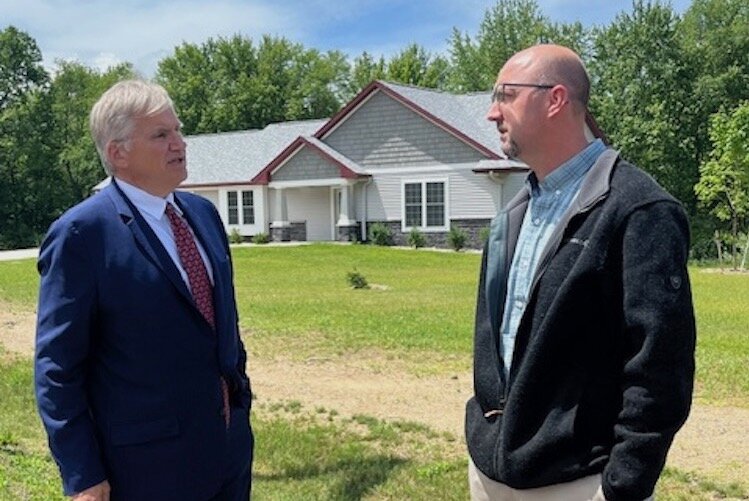
Richard Monocchio, Principal Deputy Assistant Secretary, Office of Public and Indian Housing, at left, speaks with Dan Green, Chief Planning Officer, at right, in front of one of four new homes completed as part of Phase 9 of the NHBP’s housing initi
The IHBG program is the primary means by which the Federal Government fulfills its trust responsibilities to provide adequate housing to Native Americans. The program is the single largest source of Indian housing assistance. The $1.1 billion in funding represents a 40-percent increase from last year and marks the largest-ever funding investment in Indian housing.
The $75 million to be awarded through the ICDBG program will provide eligible grantees with assistance in developing viable American Indian and Alaska Native communities.
“We know that there’s a shortage of affordable housing nationally and in Indian country,” Monocchio says. “We’re building in some set-asides for tribal entities including $235 million to build manufactured houses. We are looking at all of our funding notices and making sure tribal entities and Tribes have the opportunity for this funding.”
Included are efforts to design a less cumbersome method for grant reporting requirements in response to concerns voiced by members of the Tribal Intergovernmental Advisory Committee (TIAC) who gathered in Washington, D.C., in May with HUD leadership.
Monocchio says between 20 to 25 grant awards are made annually with dollar amounts ranging between $3 million and $7 million.
“Your great ancestors had to fight for everything just like you continue to fight,” Monocchio says. “It is important that we don’t just talk about it, but actually do something.”

